Control of the Health Risk of Radon Exposure in the Republic of Moldova
Abstract
1. Introduction
1.1. What Is the Harmfulness of Radon?
1.2. Mechanisms of Development of Tumor Processes as a Result of Exposure to Radon and Tobacco
2. Materials and Methods
2.1. Study Objectives
2.2. Methodology
2.2.1. The Criterion for Selecting the Concentration Measurement Sites of 222Rn
2.2.2. Evaluation of the Characteristics of the Dwelling
- individual dwelling on the ground, public dwelling or public building, year of construction, about the existence of the concrete foundation;
- type of floor (wood, solid parquet, tiles, laminate flooring, other);
- the materials from which the walls are built (reinforced concrete, brick, stone, wood, adobe, other);
- type of ceiling (reinforced concrete, wood, other);
- type of windows (simple, double glazing);
- presence of cracks (yes/no);
- artificial ventilation (no ventilation, fan, air conditioning).
2.2.3. Evaluation of the Population’s Knowledge Regarding the Impact of Radon on Health
2.2.4. Methodology for Building the Radon Map in Housing in the Republic of Moldova
3. Results
- The requirements for placing detectors in the dwelling;
- Questionnaires for the identification of housing conditions/type;
- The agreement between radon investigators and the owner of the dwelling;
- The questionnaire for the evaluation of the population’s knowledge regarding radon.
4. Discussion
Cluster Analysis of the Interaction of Factors “Concentration of Radon × Incidence/Prevalence of Diseases of the Respiratory System and Hemoblastoses”
5. Conclusions
- Radon concentrations were monitored in the air of different types of dwellings (n = 2500) located in rural and urban localities of different areas of the Republic of Moldova using long-term alpha detectors of the RADTRAK2 type with an exposure period of 90 days. The monitoring established the variability of the indicator depending on the geographical area, abiotic conditions, the type of house and the type of floor and walls.
- The study demonstrated an increase in radon concentrations in the air in homes in the Southern part of the country, with the average value per area constituting 330.3 Bq/m3, followed by the Center area—253.8 Bq/m3 and Northern area—237.9 Bq/m3.
- The study of the variability of radon concentration in the air of dwellings placed in different geographical districts of the Republic of Moldova revealed increased values in the Căușeni district and the lowest ones in the Chisinau municipality.
- The research shows that the average concentration of radon in dwellings was higher in rural areas (261.6 Bq/m3) compared to urban ones (243 Bq/m3).
- Through the cluster analysis, the interactions within the relationships “radon concentration × incidence/prevalence of non-communicable diseases” (Figure 7) and radon × oncological maladies interaction (Figure 8) were established. The overlapping of maps of the incidence of bronchopulmonary cancer and radon concentrations on the territory of the country (Figure 9) has shown partial interaction between these two factors, which indicates that the onset of bronchopulmonary cancer under the action of radon is a cumulative effect, determined by long-term chronic exposure and also influenced by other factors such as smoking, exogenous factors, etc.
- Mapping radon concentrations in the air of homes across the country will be useful for legislators and construction specialists to select land for the construction of buildings, resulting in a diminished radon hazard.
Author Contributions
Funding
Institutional Review Board Statement
Informed Consent Statement
Data Availability Statement
Acknowledgments
Conflicts of Interest
References
- UNSCEAR Volume I, Sources and Effects of Ionizing Radiation. In United Nations Scientific Committee on the Effect of Atomic Radiation, 2008; United Nations: New York, NY, USA, 2010.
- Coretchi, L.; Bahnarel, I.; Gîncu, M.; Cojocari, A.; Hoffmann, M. Controlul și evaluarea riscului expunerii populației la radon în Republica Moldova. OH&RM 2020, 1, 42–49. [Google Scholar] [CrossRef]
- Lantz, P.; Mendez, D.; Philbert, M. Radon, Smoking, and Lung Cancer: The need to refocus radon control policy. Am. J. Public Health 2013, 103, 443–447. [Google Scholar] [CrossRef] [PubMed]
- Medaglia, F. Exposure to Radon Increases Your Risk for Lung Cancer. Mass Public Health Blog. Promoting Public Health & Wellness in Massachusetts. 2017. Available online: https://blog.mass.gov/publichealth/environmental-health/exposure-to-Radon-increases-your-risk-for-lung-cancer/ (accessed on 10 April 2021).
- Song, G.; Zhang, B.; Wang, X.; Gong, J.; Chan, D.; Bernett, J.; Lee, S.C. Indoor radon levels in selected hot spring hotels in Guangdong, China. Sci. Total Environ. 2005, 339, 63–70. [Google Scholar] [CrossRef] [PubMed]
- Scott, B.R. Residential Radon Appears to Prevent Lung Cancer. Dose Response 2011, 9, 444–464. [Google Scholar] [CrossRef] [PubMed]
- Vuchkov, D.; Ivanova, K.; Stojanovska, Z.; Kunovska, B.; Badulin, V. Radon measurement in schools and kindergartens (Kremikovtsi municipality, Bulgaria). Rom. J. Phys. 2012, 58, S328–S335. [Google Scholar]
- Ferlay, J.; Colombet, M.; Soerjomataram, I.; Dyba, T.; Randi, G.; Bettio, M.; Gavin, A.; Visser, O.; Bray, F. Cancer incidence and mortality patterns in Europe: Estimates for 40 countries and 25 major cancers in 2018. Eur. J. Cancer 2018, 103, 356–387. [Google Scholar] [CrossRef] [PubMed]
- Lofstedt, R. The communication of radon risk in Sweden: Where are we and where are we going? J. Risk Res. 2019, 22, 773–781. [Google Scholar] [CrossRef]
- Khan, S.M.; Gomes, J. An Interdisciplinary Population Health Approach to the Radon Health Risk Management in Canada. Interdiscip. J. Health Sci. 2017, 3, 32–43. Available online: https://ruor.uottawa.ca/bitstream/10393/37336/1/RISS-IJHS5%287.1%29---FINAL-PDF-32-43.pdf (accessed on 10 April 2021). [CrossRef][Green Version]
- Biblin, A. Development of the model of radiation risk-communication with the public for the arrangement of the research. Radiatsionnaya Gygiena Radiat. Hyg. 2019, 12, 74–84. [Google Scholar] [CrossRef]
- WHO. WHO Handbook on Indoor Radon: A Public Health Perspective; Zeeb, H., Shannoun, F., Eds.; World Health Organization: Geneva, Switzerland, 2009; ISBN 978-92-4-154767. [Google Scholar]
- EU. Council Directive 2013/59/Euratom. Off. J. Eur. Commun. 2014, L13, 1–73. [Google Scholar] [CrossRef]
- European Commission, Joint Research Center, Radioactivity Environmental Monitoring, European Indoor Radon Map. Available online: https://remap.jrc.ec.europa.eu/Atlas.aspx# (accessed on 1 October 2021).
- Fundamental Norms of Radiation Protection, Requirements and Hygienic Rules (NFRP-2000) no. 06.5.3.34 of 27.02.2001; Official Monitor of the Republic of Moldova no.40–41, 2001: Chisinau, Moldova, 2001.
- RMS no. 217: Regulation and Hygienic Norms on the Regulation of Radiation Exposure of the Population from Natural Sources no.06-5.3.35 of 05.03.2001; Official Monitor of the Republic of Moldova no.92 of 03.08.2001: Kishinev, Moldova, 2001.
- Coretchi, L.; Bahnarel, I.; Vîrlan, S.; Apostol, I. Controlul, Reglementarea și Remedierea Expunerii la Radon a Populației Republicii Moldova; Tipografia “Sirius”: Chişinău, Moldova, 2020; pp. 60–77. ISBN 978-9975-57-290-3. [Google Scholar]
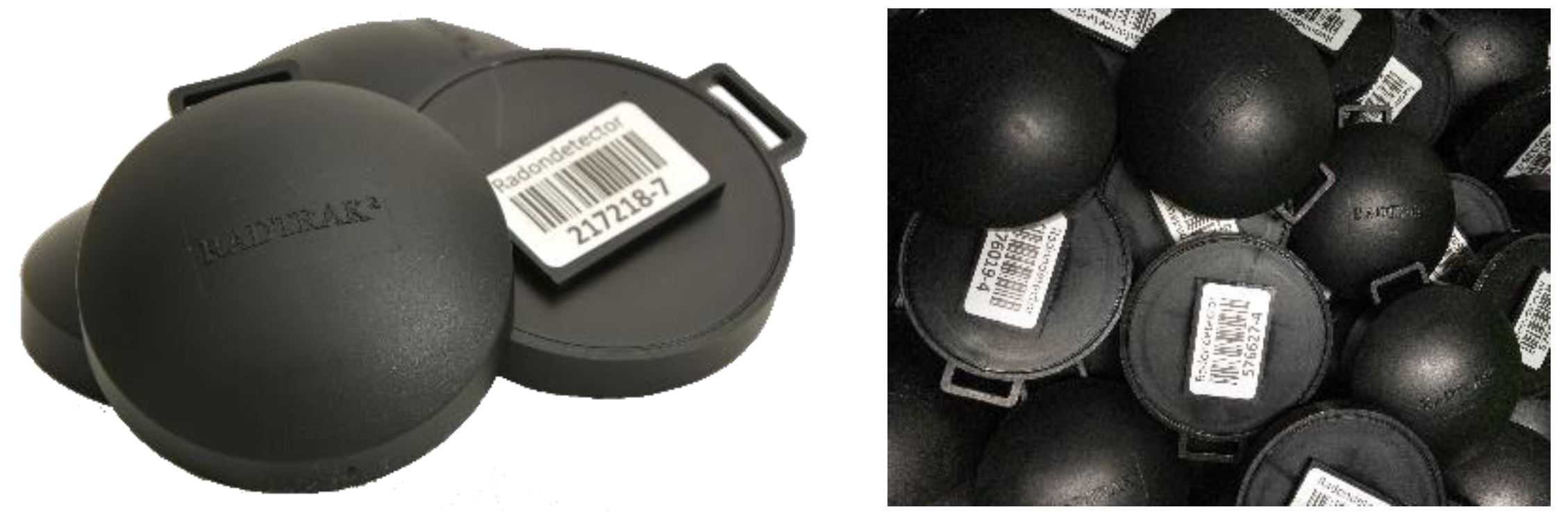
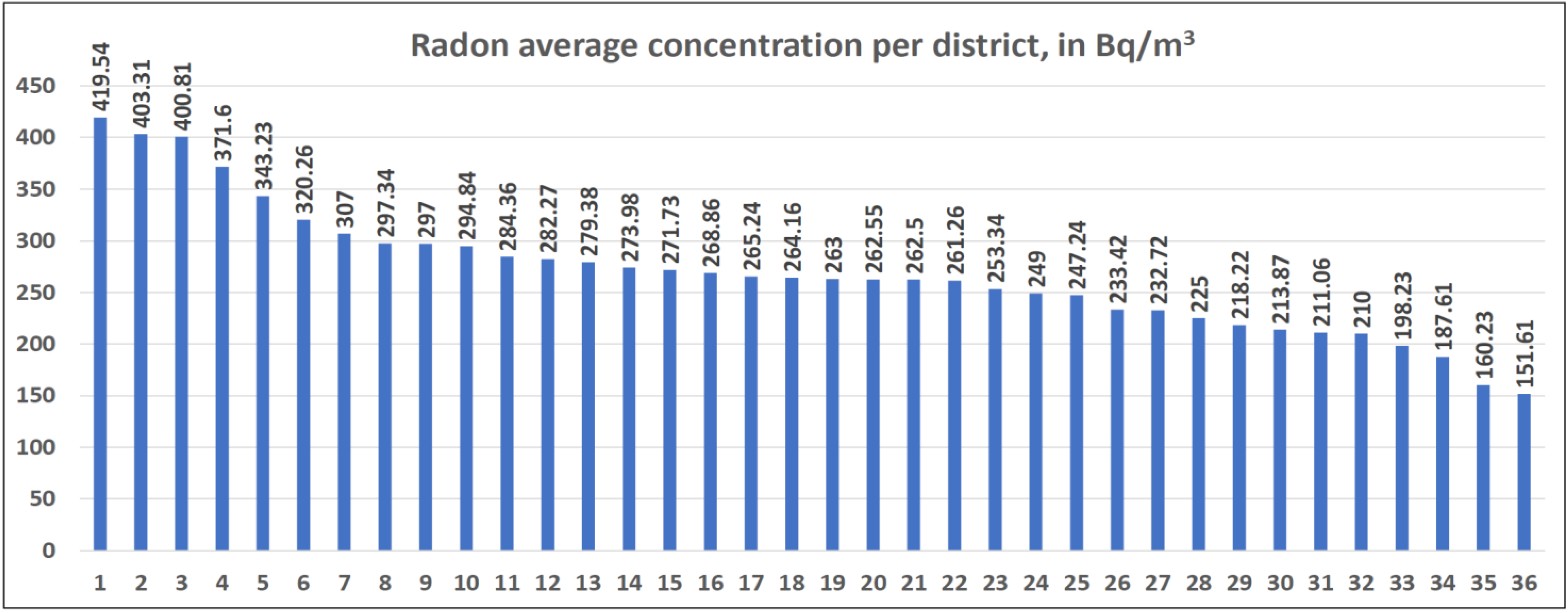
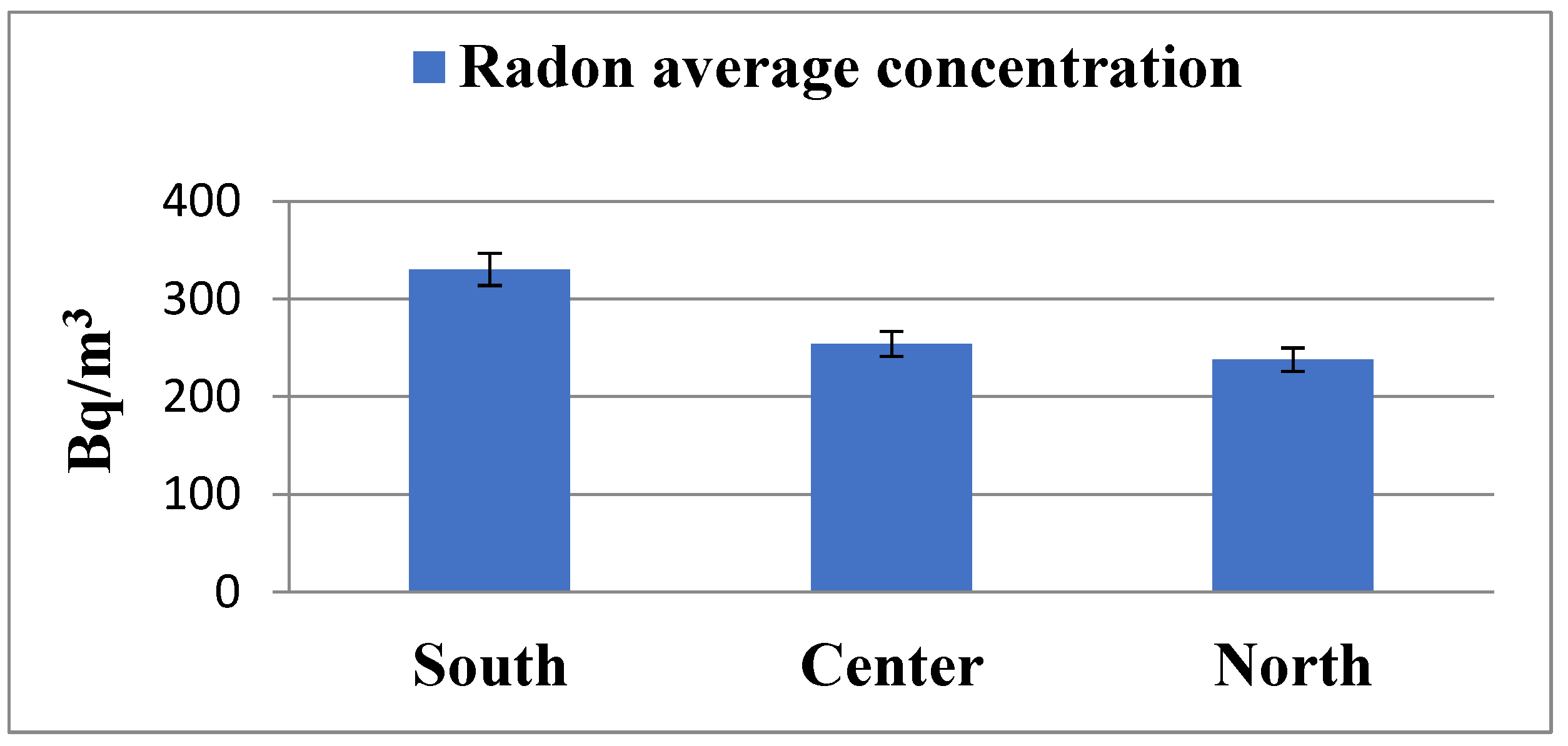
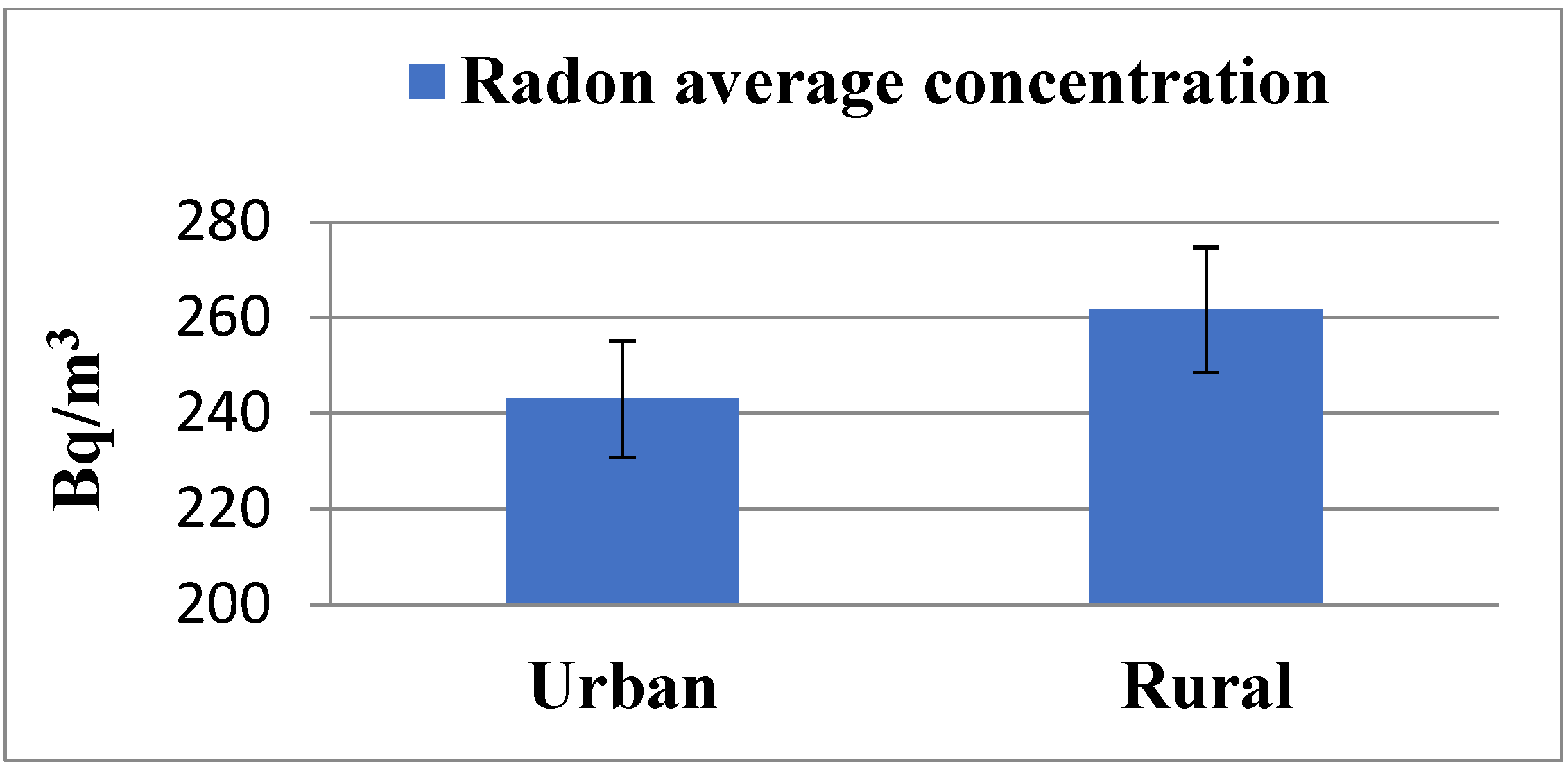
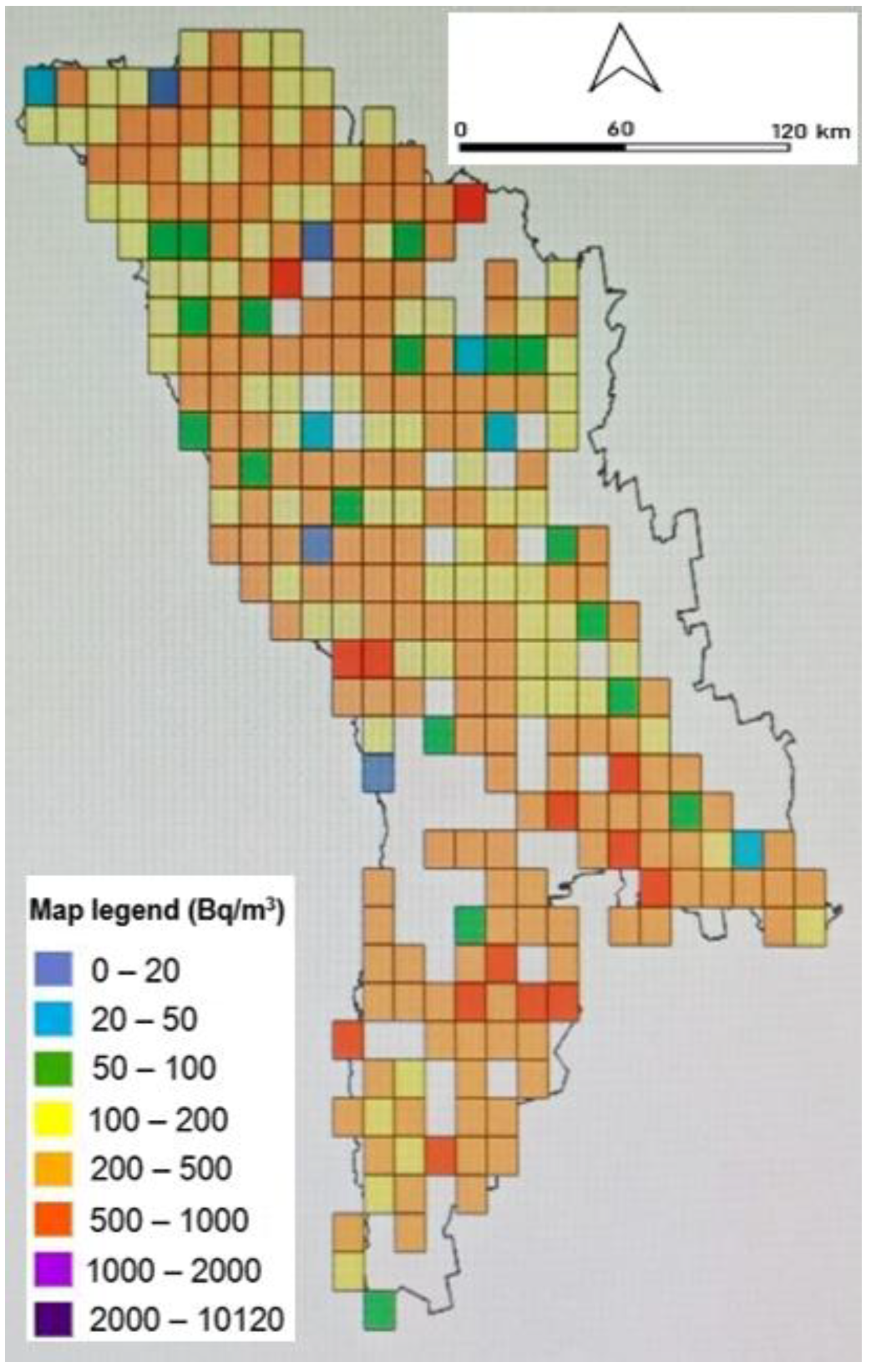
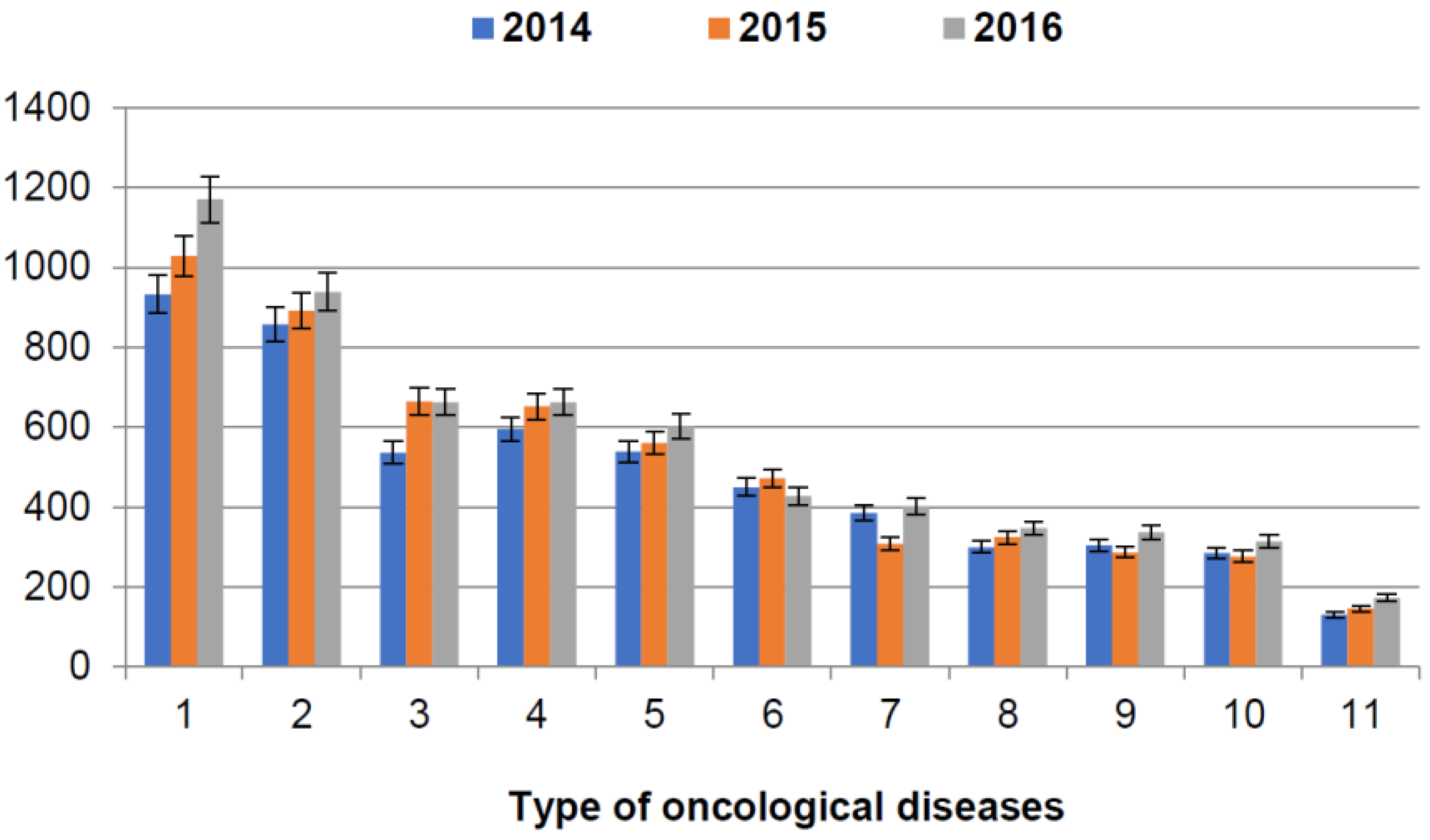
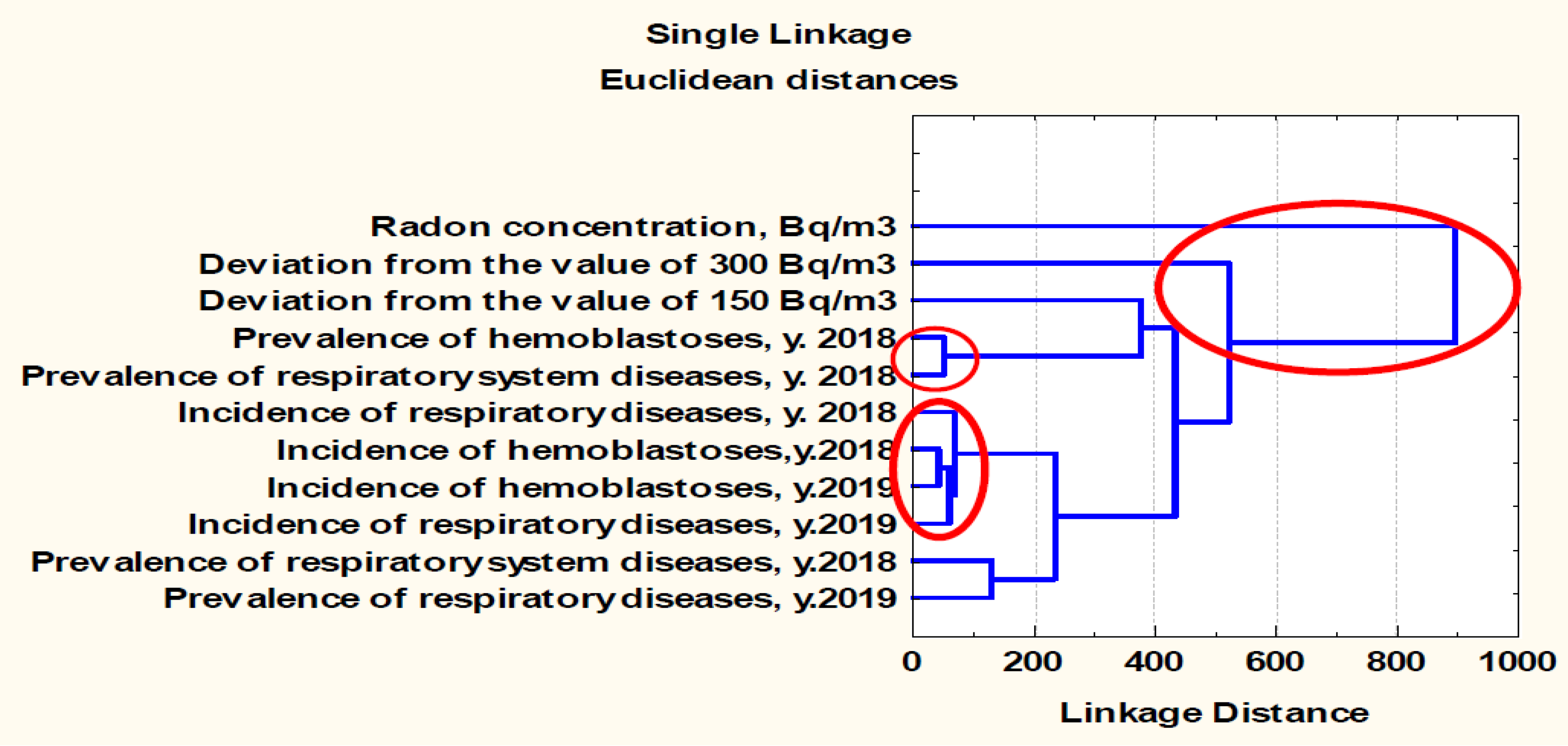
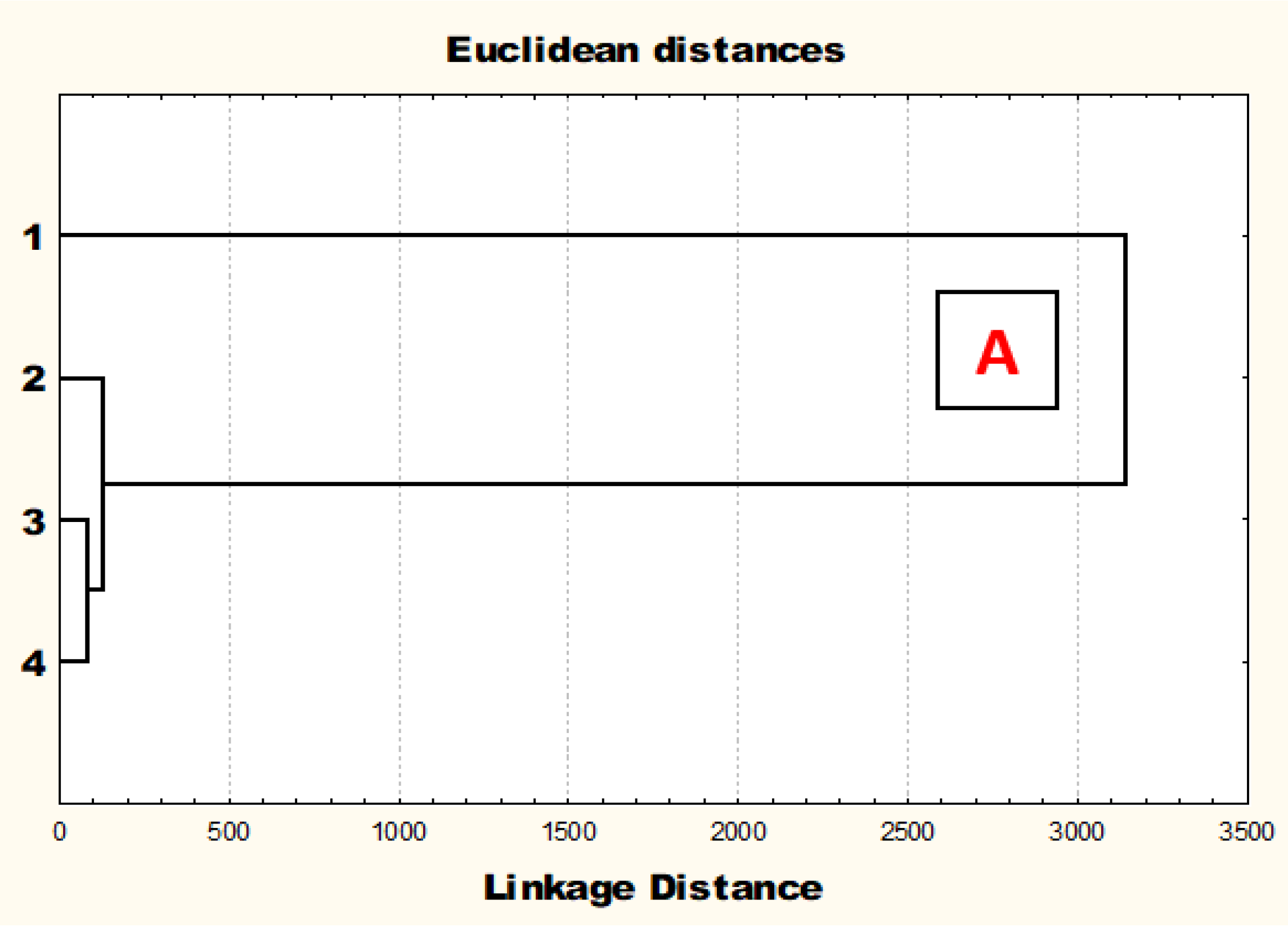
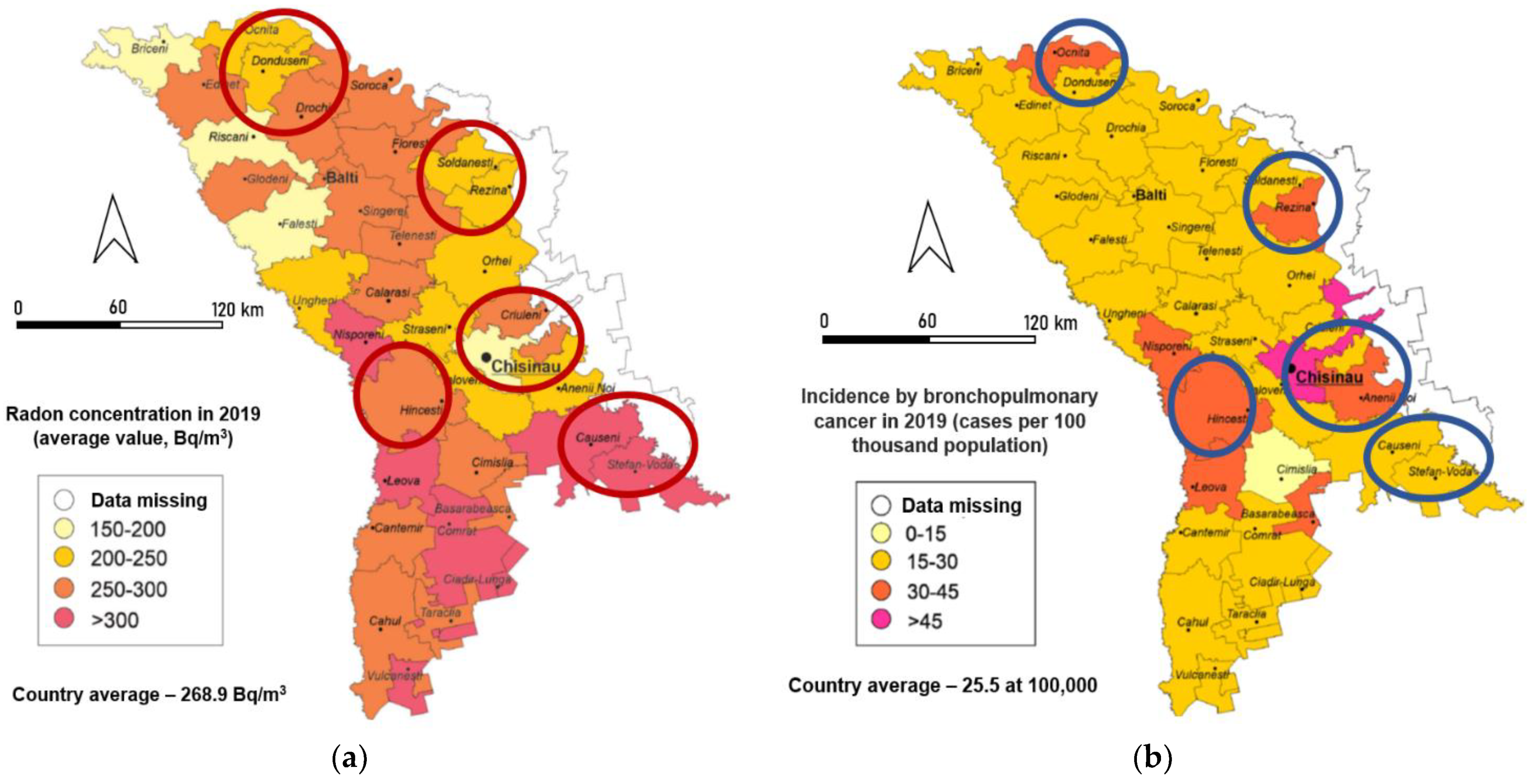
| Questions and Answers about Health Risk | Respondents, % | |
|---|---|---|
| What happens if the radon level is increased in the rooms? | Feeling sick | 34.8 |
| Suffocation | 8.1 | |
| Disorders | 21.3 | |
| Dizziness | 17.2 | |
| It affects the respiratory system, including bronchopulmonary cancer | 66.6 | |
| Do not know | 12.2 | |
| Other | 1.0 | |
| Does radon inhaled with air in rooms influence the appearance of bronchopulmonary cancer or other cancers? | Yes | 83.4 |
| No | 0.7 | |
| Do not know | 15.5 | |
| Other | 0.3 | |
| What are the consequences of chronic radon exposure? | Triggering of bronchopulmonary cancer | 80.4 |
| Triggering of other diseases of the respiratory system | 19.6 | |
| Nervous system disorders | 11.1 | |
| Cardiovascular diseases | 7.4 | |
| Digestive disorders | 2.0 | |
| Do not know | 13.9 | |
| Other | 0.3 | |
| More often, what type of cancer can cause radon exposure? | Lung | 85.5 |
| Duodenum | 2.0 | |
| Cutaneous | 2.7 | |
| Osseous | 2.0 | |
| Do not know | 12.2 | |
| Other | 0.0 | |
| No. | Radon Concentration, Bq/m3 | Number of Houses | % |
|---|---|---|---|
| 1 | Up to 150 | 1170 | 49 |
| 2 | 160–290 | 615 | 25 |
| 3 | 300–490 | 338 | 13.52 |
| 4 | 500–790 | 251 | 10.04 |
| 5 | 800–990 | 58 | 2.3 |
| 6 | >1000 | 15 | 0.6 |
| Region | Variable | |||||||
|---|---|---|---|---|---|---|---|---|
| Valid n | Average | SD | Min | Max | Median | GM | GSD | |
| Republic of Moldova | 2435 | 252.8 | 215.9 | 10 | 1480 | 200 | 158.5 | 3.0 |
| Urban area | 1147 | 243.0 | 225.9 | 10 | 1260 | 170 | 140.3 | 3.3 |
| Rural area | 1287 | 261.6 | 206.2 | 10 | 1480 | 220 | 176.9 | 2.8 |
Publisher’s Note: MDPI stays neutral with regard to jurisdictional claims in published maps and institutional affiliations. |
© 2021 by the authors. Licensee MDPI, Basel, Switzerland. This article is an open access article distributed under the terms and conditions of the Creative Commons Attribution (CC BY) license (https://creativecommons.org/licenses/by/4.0/).
Share and Cite
Coretchi, L.; Ene, A.; Ababii, A. Control of the Health Risk of Radon Exposure in the Republic of Moldova. Atmosphere 2021, 12, 1302. https://doi.org/10.3390/atmos12101302
Coretchi L, Ene A, Ababii A. Control of the Health Risk of Radon Exposure in the Republic of Moldova. Atmosphere. 2021; 12(10):1302. https://doi.org/10.3390/atmos12101302
Chicago/Turabian StyleCoretchi, Liuba, Antoaneta Ene, and Aurelia Ababii. 2021. "Control of the Health Risk of Radon Exposure in the Republic of Moldova" Atmosphere 12, no. 10: 1302. https://doi.org/10.3390/atmos12101302
APA StyleCoretchi, L., Ene, A., & Ababii, A. (2021). Control of the Health Risk of Radon Exposure in the Republic of Moldova. Atmosphere, 12(10), 1302. https://doi.org/10.3390/atmos12101302







